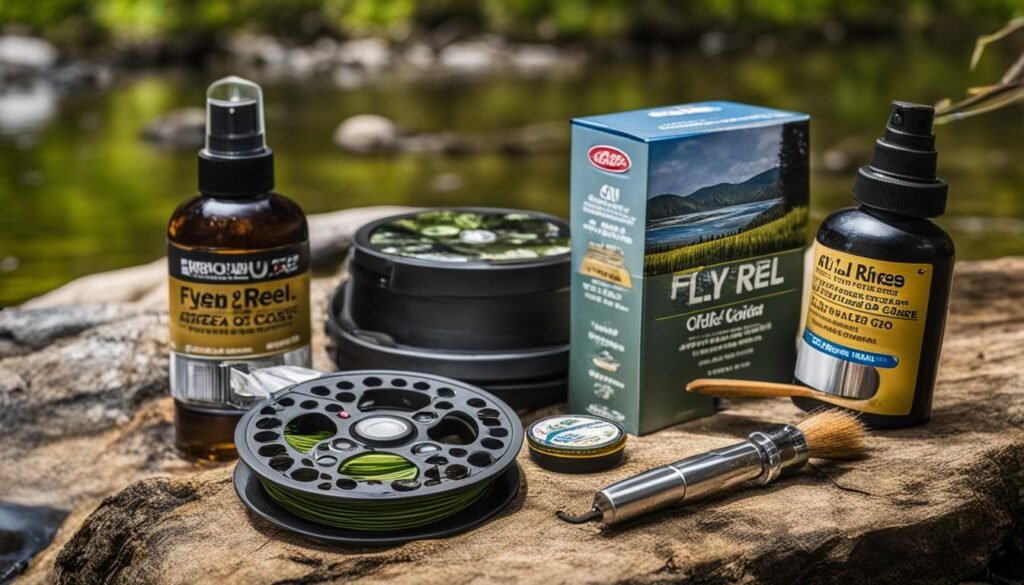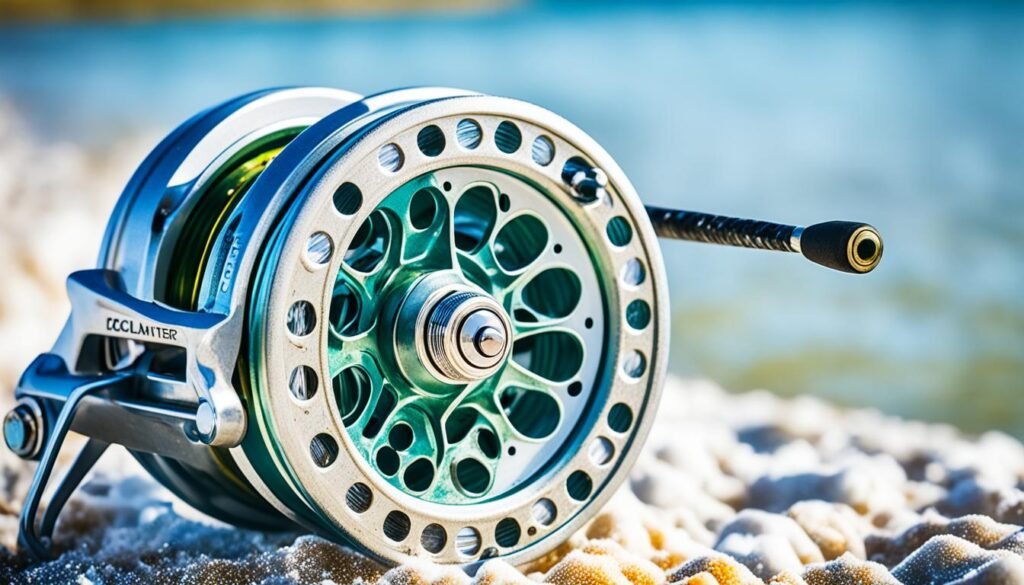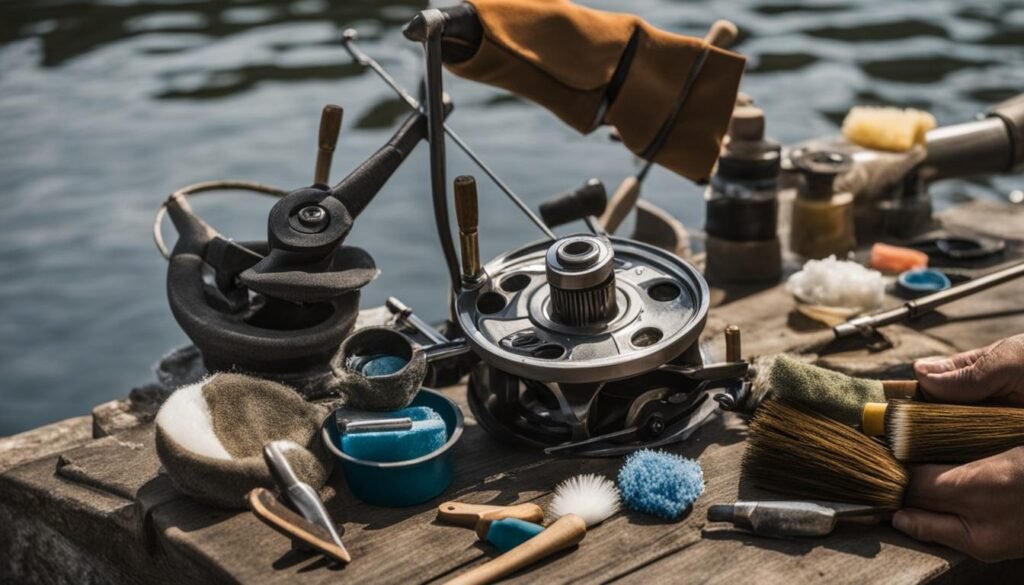Properly cleaning and maintaining your fly reel is essential for its longevity and peak performance. By following these step-by-step instructions and best practices, you can ensure that your fly reel stays in top shape and ready for your next fishing adventure.
When it comes to cleaning a fly reel, there are a few important things to keep in mind. Regular maintenance not only keeps your reel functioning smoothly but also prevents dirt and debris from affecting its performance. By taking the time to properly clean your fly reel, you can extend its lifespan and enjoy optimal performance while casting and reeling in your catches.
Key Takeaways:
- Follow a step-by-step guide to clean your fly reel properly.
- Regular cleaning and maintenance help prevent dirt and debris build-up.
- Proper cleaning extends the lifespan of your fly reel and ensures optimal performance.
- Take care of your fly reel to streamline your fly fishing experience.
- Use recommended aftercare products for enhanced longevity and performance.
Why Should You Clean Your Fly Reel?
Regular cleaning of your fly reel is crucial for maintaining its optimal performance and ensuring a smooth casting experience. Neglecting to clean your fly reel can lead to a buildup of dirt and algae, which can have a negative impact on its overall functionality. Let’s explore the importance and benefits of cleaning a fly reel:
“Regular cleaning of your fly reel is crucial for maintaining its optimal performance and ensuring a smooth casting experience.”
The Impact of Dirt and Algae on Fly Reel Performance
Over time, dirt and algae can accumulate on the internal and external parts of your fly reel. This build-up can result in kinks in your fishing line and increased line memory. Kinks in the line can cause tangles and reduce casting distance, while line memory can affect the line’s ability to lay out straight, negatively impacting accuracy and presentation.
Prevention of Kinks and Line Memory
By regularly cleaning your fly reel, you can prevent the accumulation of dirt and algae that can lead to kinks and line memory issues. Cleaning removes any residue and ensures smooth operation of the reel’s mechanisms, reducing the risk of line damage and maintaining optimal casting performance.
Improved Casting Performance
A clean fly reel facilitates improved casting performance. By removing dirt and algae, you reduce friction and resistance when casting, allowing the line to glide effortlessly through the guides. This results in smoother line release, increased casting distance, and improved accuracy, ultimately enhancing your overall fly fishing experience.

Regularly cleaning your fly reel is an essential aspect of proper maintenance. By taking the time to clean and maintain your reel, you can extend its longevity, prevent performance issues, and enjoy consistently successful fly fishing outings.
How Often Should You Clean Your Fly Reel?
Proper maintenance and cleaning of your fly reel are essential for its longevity and optimal performance. The frequency of cleaning your fly reel depends on the conditions in which you fish. Let’s explore how often you should clean your fly reel based on different scenarios:
Cleaning After Every Outing
If you fish in algae-covered lakes or ponds, it is recommended to clean your fly reel after every three or four outings. Algae and dirt can accumulate on your reel, affecting its performance and potentially leading to damage. By cleaning your fly reel regularly, you can prevent the build-up of debris and maintain a smooth and efficient fishing experience.
Cleaning in Freshwater versus Saltwater
The type of water you fish in also affects how often you should clean your fly reel. In clean, cold freshwater, you may be able to go longer between cleaning sessions, as the water doesn’t contain as many contaminants that can impact your reel’s performance. However, if you are a saltwater angler, it is advisable to clean your fly reel multiple times per trip.
Saltwater is corrosive, and salt can quickly build up on your reel, leading to damage if not properly cleaned. To protect your reel from saltwater corrosion, it is crucial to clean it thoroughly after each saltwater fishing trip.
Tip: If you are unsure about the cleanliness of the water you fish in, it’s always better to err on the side of caution and clean your fly reel more frequently.

Here is a comparative table summarizing the recommended cleaning frequency for different fishing conditions:
| Fishing Conditions | Cleaning Frequency |
|---|---|
| Algae-covered lakes or ponds | Every three or four outings |
| Clean, cold freshwater | Every few outings |
| Saltwater fishing | Multiple times per trip |
By following these guidelines, you can keep your fly reel in top condition, ensuring optimal performance and a longer lifespan for your fishing gear.
How to Clean Your Fly Reel
Properly cleaning and maintaining your fly reel is essential for its longevity and peak performance. By following these step-by-step instructions and best practices, you can ensure that your fly reel stays in top shape and ready for your next fishing adventure.
Gather Your Materials
Before you begin cleaning your fly reel, make sure you have the following materials on hand:
- Warm water
- Hand soap
- Bucket
- Wet cloth
- Chamois cloth
- Line dressing product
Cleaning Steps
- Pump a few squirts of hand soap into warm water in a bucket.
- Remove the line from the reel and let it soak in the soapy water for about 25 minutes.
- Run the fly line between a wet cloth to remove dirt and soap residue.
- Replace the soapy water with non-soapy water and repeat the process until the line is clean.
- Rinse the line thoroughly to remove any remaining soap.
- Dry the line with a chamois cloth to remove moisture.
- Reattach the fly line to the reel with the appropriate knot.
Note: Follow any specific instructions provided by the reel manufacturer for disassembling and cleaning reel components.
Enhancing Performance with Line Dressing
After cleaning your fly reel, you can further enhance the performance and longevity of your fly line by using a line dressing product. This product lubricates and protects the line, ensuring it stays in optimal condition. Apply the line dressing as per the product instructions to maximize the benefits.

Aftercare of Your Fly Reel
After cleaning your fly reel, it’s important to use high-quality products for its aftercare to maintain its longevity and optimize its performance. These specially designed products can help keep your fly line scratch-resistant, strong, crack-free, and shooting straight.
Recommended Products for Fly Reel Aftercare
- AgentX Fly Line Dressing: This product enhances performance, lubricates the line, and keeps it clean, ensuring smooth casts and minimal friction.
- Loon Outdoors Line Cleaning Tool: Featuring a sheepskin pad, this tool is perfect for applying line cleaner and removing any dirt or debris.
- Loon Outdoors Line Speed: Known as the best line cleaner, conditioner, and UV block for fly lines, this product provides long-lasting protection and improved line speed.
- Scientific Anglers Fly Line Dressing with Cleaning Pad: Specifically designed to clean and protect fly lines, this product ensures reliable performance and prolongs the life of your line.
By using these aftercare products, you can extend the lifespan of your fly reel and enjoy optimal performance every time you hit the water.

Remember to always follow the manufacturer’s instructions when using these products to ensure the best results. With proper aftercare, your fly reel will remain in excellent condition for countless fishing adventures to come.
Importance of Cleaning Freshwater and Saltwater Fishing Reels
Regardless of whether you fish in freshwater or saltwater, regular cleaning of your fishing reels is essential to maintain their longevity and functionality. However, it’s crucial to pay extra attention to cleaning saltwater fishing reels due to the corrosive nature of saltwater. Failure to clean saltwater reels after each use can result in the accumulation of salt and minerals, leading to potential damage.
When fishing in freshwater, cleaning your reels at regular intervals helps remove dirt, debris, and other contaminants that can affect their performance. By preventing the accumulation of these elements, you can ensure that your reels function smoothly and efficiently throughout your fishing trips.
On the other hand, saltwater fishing reels require more frequent cleaning due to the corrosive effects of the saltwater environment. Salt and minerals can quickly build up on the reels and cause damage if left uncleaned. By cleaning saltwater reels after each use, you can prevent corrosion, extend their lifespan, and maintain their optimal performance.
To highlight the differences in cleaning freshwater and saltwater fishing reels:
- Freshwater Fishing Reels: Regular cleaning at intervals helps remove dirt, debris, and contaminants that can affect their performance.
- Saltwater Fishing Reels: It is necessary to clean these reels after each use to prevent the buildup of salt and minerals, which can lead to corrosion and damage.
By understanding the specific cleaning requirements for each type of fishing reel, you can take the necessary steps to prevent damage, ensure their longevity, and enjoy optimal performance on all your fishing adventures.

| Cleaning Considerations | Freshwater Fishing Reels | Saltwater Fishing Reels |
|---|---|---|
| Cleaning Frequency | Regular intervals to remove dirt, debris, and contaminants. | After each use to prevent salt and mineral buildup. |
| Cleaning Process | Thorough cleaning with warm soapy water, rinsing, and air drying. | Thorough cleaning with freshwater and appropriate cleaning agents for salt removal, rinsing, and air drying. |
| Focus Areas | Removing dirt and contaminants from the reel’s body, spool, and line components. | Removing salt, minerals, and other corrosive substances from the reel’s body, spool, and line components. |
By prioritizing regular cleaning and maintenance, you can protect your freshwater and saltwater fishing reels from damage and ensure they consistently perform at their best. Remember to follow manufacturer guidelines and use appropriate cleaning products for each type of reel to maintain their longevity and functionality.
Steps for Cleaning a Fishing Reel After Use
Properly cleaning your fishing reel after each use is crucial for maintaining its performance and prolonging its lifespan. Follow these steps to ensure your reel stays clean and functional:
- Tighten Down the Drag: Before cleaning, make sure to tighten down the drag on your reel. This prevents water from entering delicate internal components and causing damage.
- Rinse Off the Reel: Using a gentle spray of water, rinse off the entire reel to remove any salt, sand, or debris that may have accumulated during your fishing trip. Avoid using pressurized water, as it can force water into the reel’s inner workings.
- Air-Drying or Towel-Drying: After rinsing, allow the reel to air-dry completely before storing it. Alternatively, you can use a clean towel to gently dry the reel and remove any remaining moisture.
- Apply Corrosion-Inhibitor/Lubricant: To protect the reel’s metal parts from corrosion and ensure smooth operation, apply a high-quality corrosion-inhibitor/lubricant. Be sure to follow the manufacturer’s instructions for proper application.
- Clean Spinning Reel Components: For spinning reels, it’s important to clean the undersides of the spool and drag cap. Use a soft cloth or brush to remove any grit, grime, or fishing line residue.
By following these cleaning steps, you can prevent water intrusion, remove dirt and debris, and maintain the optimal performance of your fishing reel. Regular maintenance will ensure that your reel continues to perform at its best, providing you with a reliable tool for your fishing adventures.

Expert Tip:
Remember to check your reel’s manual for any specific cleaning instructions provided by the manufacturer. Some reels may have special maintenance requirements or recommend the use of specific cleaning products.
Steps for Deep-Cleaning a Fishing Reel
Periodically, you should deep-clean your fishing reel to maintain its optimal performance and address any unusual grinding noises or decreased smoothness. Follow these steps for deep-cleaning:
-
Remove the reel from the fishing rod and clean the reel foot.
-
Clean the reel as instructed in the previous section.
-
Remove the handle, clean its metal parts, and apply fresh lubrication.
-
Remove the side-plate to access hard-to-reach areas, such as the spool bearing and clicker assembly (for conventional reels).
-
Clean out old lubricant and replace it with fresh lubricant according to the manufacturer’s recommendations.
These steps ensure a thorough cleaning and maintenance of your fishing reel, improving its longevity and performance.

Conclusion
Proper care and regular maintenance are essential for ensuring the longevity and optimal performance of your fly reel. By regularly cleaning your fly reel, you can prevent the buildup of dirt and algae, which can lead to kinks in the line and decreased casting performance. Following the step-by-step cleaning instructions and using recommended aftercare products can help you keep your fly reel in excellent condition.
By making cleaning your fly reel a part of your regular maintenance routine, you can enjoy the benefits of improved longevity and enhanced performance. A clean fly reel will ensure smooth casting, preventing line memory and maintaining the integrity of your fishing line. With proper care, your fly reel will be ready for years of successful fly fishing adventures.
Remember to follow the recommended cleaning techniques and use high-quality aftercare products to keep your fly reel in top shape. By taking care of your fly reel, you can enjoy the full performance benefits and ensure that it stays in excellent condition for years to come.
FAQ
Why should you clean your fly reel?
Properly cleaning and maintaining your fly reel is crucial for its longevity and optimal performance. Regular cleaning prevents dirt and algae buildup, which can impact the performance of your fly reel over time. It helps prevent kinks in the line and reduces line memory, resulting in a smoother and more accurate casting experience.
How often should you clean your fly reel?
The frequency of cleaning your fly reel depends on the conditions in which you fish. If you fish in algae-covered lakes or ponds, it is recommended to clean your fly reel every three or four outings. Fishing in clean, cold water may allow you to go longer between cleaning sessions. However, if you are a saltwater angler, it is advisable to clean your fly reel multiple times per trip due to the quick buildup of salt.
How do you clean a fly reel?
To clean your fly reel, you will need warm water, hand soap, a bucket, a wet cloth, a chamois cloth, and a line dressing product. Follow these steps: pump a few squirts of hand soap into warm water in a bucket, remove the line from the reel and let it soak in the soapy water for about 25 minutes, run the fly line between a wet cloth to remove dirt and soap residue, replace the soapy water with non-soapy water and repeat the process until the line is clean, rinse the line thoroughly to remove any remaining soap, dry the line with a chamois cloth to remove moisture, and reattach the fly line to the reel with the appropriate knot.
What aftercare products can you use for your fly reel?
After cleaning your fly reel, you can use products specifically designed for aftercare to extend its longevity and improve its performance. Some recommended products include: AgentX Fly Line Dressing, Loon Outdoors Line Cleaning Tool, Loon Outdoors Line Speed, and Scientific Anglers Fly Line Dressing with Cleaning Pad. These products help keep your fly line scratch-resistant, strong, crack-free, and shooting straight.
Why is it important to clean both freshwater and saltwater fishing reels?
Regardless of whether you fish in freshwater or saltwater, it is essential to regularly clean your fishing reels. However, cleaning saltwater fishing reels requires extra attention due to the corrosive nature of saltwater. Salt and minerals can accumulate on the reels, leading to damage if not properly cleaned after each use. Cleaning both freshwater and saltwater fishing reels helps protect the gear and ensure its long-term functionality.
How do you clean a fishing reel after use?
After each fishing trip, it is important to follow these steps to effectively clean your fishing reel: tighten down the drag to prevent water intrusion, rinse off the reel with a gentle spray, avoiding the use of pressurized water, allow the reel to air-dry or towel it dry, and apply a quality corrosion-inhibitor/lubricant to clean the reel’s metal parts. Additionally, for spinning reels, clean the undersides of the spool and drag cap to remove any grit and grime.
How do you deep-clean a fishing reel?
Periodically, you should deep-clean your fishing reel to maintain its optimal performance and address any unusual grinding noises or decreased smoothness. Follow these steps for deep-cleaning: remove the reel from the fishing rod and clean the reel foot, clean the reel using the steps mentioned above, remove the handle, clean its metal parts, and apply fresh lubrication, remove the side-plate to access hard-to-reach areas, such as the spool bearing and clicker assembly (for conventional reels), and clean out old lubricant and replace it with fresh lubricant according to the manufacturer’s recommendations.
Why is it important to clean a fly reel?
Properly cleaning and maintaining your fly reel is crucial for its longevity and optimal performance. Regular cleaning prevents dirt and algae buildup, which can impact the performance of your fly reel over time. It helps prevent kinks in the line and reduces line memory, resulting in a smoother and more accurate casting experience.

